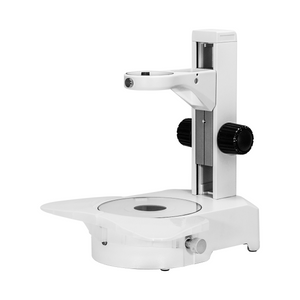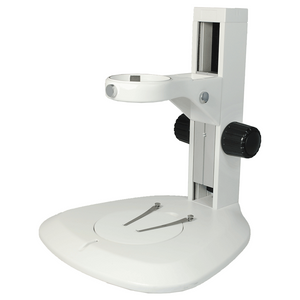Instruction Manual
SA0516 Illumination Base Instruction Manual-English.doc
Quick Overview
Clear Glass Plate. Plate Size: Dia. 100x6mm. Transmitted Mirror Base. Illumination Base Adapter Size: Dia. 46mm. Single Side Plane Mirror. For ST0501, ST1901 Series Post Stand. ST0503, ST2703 Series Track Stand. For ST05031101 Track Stand.
SA0516 Illumination Base Instruction Manual-English.doc
Quick Overview
Clear Glass Plate. Plate Size: Dia. 100x6mm. Transmitted Mirror Base. Illumination Base Adapter Size: Dia. 46mm. Single Side Plane Mirror. For ST0501, ST1901 Series Post Stand. ST0503, ST2703 Series Track Stand. For ST05031101 Track Stand.
SA05161101 Transmitted Light Base (Halogen Light Adapter)
Microscope Plate
| 100x6mm Clear Glass Plate | |
| Plate Type | Clear Glass Plate |
| Plate Size | Dia. 100x6mm |
| Material | Clear Float Glass |
| Color | White |
| Net Weight | 0.11kg (0.24lbs) |
| Applied Field | For ST0501, ST1901 Series Post Stand. ST0503, ST2703 Series Track Stand |
Illumination Base
| Illumination Base Type | Transmitted Mirror Base |
| Illumination Base Adapter Size | Dia. 46mm |
| Illumination Base Dimensions | 230x180x55mm |
| Mirror Type | Single Side Plane Mirror |
| Mirror Rotatable Range | 360° |
| Mirror Diameter | Dia. 70mm |
| Surface Treatment | Spray Paint |
| Material | Metal |
| Color | White |
| Net Weight | 0.99kg (2.18lbs) |
| Applied Field | For ST05031101 Track Stand |
Technical Info
Instructions
IlluminatorClose Λ
| The conditions of different illumination of the microscope are a very important parameter. Choosing the correct illumination method can improve the resolution and contrast of the image, which is very important for observing the imaging of different objects. The wavelength of the light source is the most important factor affecting the resolution of the microscope. The wavelength of the light source must be smaller than the distance between the two points to be observed in order to be distinguished by the human eye. The resolution of the microscope is inversely proportional to the wavelength of the light source. Within the range of the visible light, the violet wavelength is the shortest, providing also the highest resolution. The wavelength of visible light is between 380~780nm, the maximum multiple of optical magnification is 1000-2000X, and the limit resolution of optical microscope is about 200nms. In order to be able to observe a much smaller object and increase the resolution of the microscope, it is necessary to use light having a much shorter wavelength as the light source. The most commonly used technical parameters for describing illumination are luminescence intensity and color temperature. Luminescence intensity, with lumen as unit, is the physical unit of luminous flux. The more lumens, the stronger the illumination. Color temperature, with K (Kelvin) as unit, is a unit of measure indicating the color component of the light. The color temperature of red is the lowest, then orange, yellow, white, and blue, all gradually increased, with the color temperature of blue being the highest. The light color of the incandescent lamp is warm white, its color temperature is 2700K, the color temperature of the halogen lamp is about 3000K, and the color temperature of the daylight fluorescent lamp is 6000K. A complex and complete lighting system can include a light source, a lampshade or lamp compartment, a condenser lens, a diaphragm, a variety of wavelength filters, a heat sink cooling system, a power supply, and a dimming device etc. Select and use different parts as needed. Of which, selection and use of the illuminating light source is the most important part of the microscope illumination system, as and other components are designed around the illuminating wavelength curve and characteristics of the illuminating light source. Some of the microscope light sources are pre-installed on the body or frame of the microscope, and some are independent. There are many types and shapes of light sources. Depending on the requirements of the microscope and the object to be observed, one type or multiple types of illumination at the same time can be selected. In addition, the whole beam and band adjustment of the light source, the position and illumination angle of the light source, and the intensity and brightness of the light all have a great influence on the imaging. For microscope imaging, a good lighting system may be a system that allows for more freedom of adjustment. In actual work, such as industry, too many adjustment mechanisms may affect the efficiency of use, therefore choose the appropriated configured lighting conditions is very important. |
Microscope PlateClose Λ
| According to different objects to be observed, the appropriate platen should be selected. The microscope plate materials include black and white, black and white finish; transparent glass, frosted glass, metal, etc. Standard stands are generally configured with a suitable microscope plate, but different plates may need to be purchased separately. Black and white microscope plate are made of general plastics, and the different backgrounds in black and white make the object more prominent. Finish microscope plate eliminates reflections during observation. Transparent glass plate is used when observing transparent or translucent objects, and the use of transmitted light source is to make the light penetrate the object to be observed as much as possible. Finish glass plate, with its rough glass surface, can make the transmitted light more uniform and create a diffusing effect, avoiding exposure of the light shadow of the filament directly onto to the observed object. Metal plate, relatively more solid, is more suitable when it is necessary to operate and cut. Microscope plate is generally round shaped, on one side of the base there is a spring clip. When installing, align the plate with the clamp and push it in, and then press down the other end, so that the plate is smoothly embedded in to the circular card slot of the bottom plate. When removing, grab the other end of the clip, push and lift up the plate. |
PackagingClose Λ
| After unpacking, carefully inspect the various random accessories and parts in the package to avoid omissions. In order to save space and ensure safety of components, some components will be placed outside the inner packaging box, so be careful of their inspection. For special packaging, it is generally after opening the box, all packaging boxes, protective foam, plastic bags should be kept for a period of time. If there is a problem during the return period, you can return or exchange the original. After the return period (usually 10-30 days, according to the manufacturer’s Instruction of Terms of Service), these packaging boxes may be disposed of if there is no problem. |
| Contains | |||||||
| Parts Including | |||||||
| |||||||
| Packing | |
| Packaging Type | Carton Packaging |
| Packaging Material | Corrugated Carton |
| Packaging Dimensions(1) | 29x26x12cm (11.417x10.236x4.724″) |
| Inner Packing Material | Plastic Bag |
| Ancillary Packaging Materials | Expanded Polystyrene |
| Gross Weight | 1.33kg (2.93lbs) |
| Minimum Packaging Quantity | 1pc |
| Transportation Carton | Carton Packaging |
| Transportation Carton Material | Corrugated Carton |
| Transportation Carton Dimensions(1) | 29x26x12cm (11.417x10.236x4.724″) |
| Total Gross Weight of Transportation(kilogram) | 1.33 |
| Total Gross Weight of Transportation(pound) | 2.93 |
| Quantity of One Transportation Carton | 1pc |
  |


















